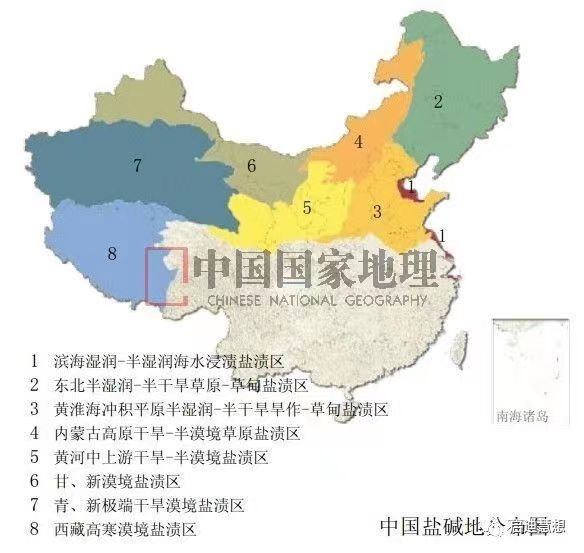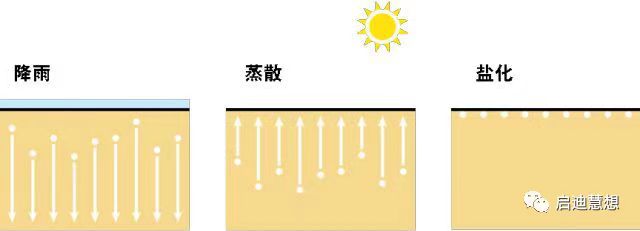Land salinization
一. Introduction
At present, soil salinization has become a global problem. Salin and alkaline land refers to the phenomenon of elevated underground diving potential and increased mineralization, coupled with arid climate and strong evaporation, which leads to the migration of deep soil salt to topsoil and the increase of topsoil salinization or alkalinization.Soil salinization is divided into two categories: primary salinization and secondary salinization. Among them, without human influence, the naturally occurring soil salinization is primary salinization, while the soil salinization caused by human activities is reduced to secondary salinization. Soil salinization is not only a major factor restricting the development of agricultural production, but also an important influencing forestry projects such as the improvement and greening of saline and alkaline land and the construction of coastal shelterbelts in coastal areas.
二.Reasons analysis
(一)Natural conditions
Salt moves with water, and both soil and groundwater contain a certain amount of salt, so the movement of soil moisture has an important impact on the accumulation of salt in the soil. The shallower the groundwater, the stronger the evaporation, and the easier it is to cause surface salt accumulation. It can be seen that the depth of groundwater affects the salinization of the soil to a certain extent.
1.Climatic conditions
In the arid and semi-arid areas of Northeast China, Northwest China and North China, the precipitation is small and the evaporation is large, and the salt dissolved in water is easy to accumulate on the surface of the soil. Climatic conditions have an important impact on the movement of water. Atmospheric precipitation can replenish surface water and groundwater. Atmospheric water evaporation causes soil water to form upward movement. It can be seen that climatic conditions are an important prerequisite for causing soil salinization. In arid and semi-arid areas in northern China, soil evaporation is greater than rainfall. Soil salinity moves up with the evaporation of water, so that salt accumulates on the surface of the soil. In this process is repeated for a long time, it will cause soil salinization.

2.Geographical conditions
The height of the terrain has a great impact on the formation of saline and alkaline soil. The terrain directly affects the movement of surface water and groundwater, which is closely related to the movement and accumulation of salt. From the perspective of large terrain, water-soluble salt moves from high to low with water and accumulates in low-lying areas. Salin and alkaline soil is mainly distributed in inland basins, mountain depressions and plain areas with poor drainage, such as the Songliao Plain. From the perspective of small terrain (local scope), the soil salt accumulation is the opposite of the large terrain, and the salin tends to accumulate in the local small convex. 3. Geological conditions.Texture thickness can affect the speed and height of soil capilla water movement. Generally speaking, loam soil capilla water rises faster and high in height, and sand and clay salt accumulation are slower. The key problems of groundwater affecting soil salinity are the level of groundwater and the degree of groundwater mineralization. The groundwater level is high, the mineralization degree is large, and it is easy to accumulate salt.

3. Hydrological conditions
The land on both sides of the river and the channel raises the groundwater level due to the seepage on the side of the river, which promotes salt accumulation. Coastal areas can be impregnated by seawater, which can form coastal saline and alkaline soil.
(二)Man-made activities
Human activities mainly affect the salinization of the soil by changing natural conditions. For example, in some places, the water is flooded, or low-lying areas are only irrigated and not drained, so that the groundwater level rises quickly and salt accumulates, turning the original good land into saline and alkaline land. This process is called secondary salinization. In order to prevent secondary salinization, water conservancy facilities should be drained and irrigated. It is strictly forbidden to flood large water. After irrigation, it should be ploughed in time.

二.Influence
1.Salt damage:
 Excessive soluble salts will affect crop water absorption, make it difficult for crops to absorb water, and may cause seedling burning.
Excessive soluble salts will affect crop water absorption, make it difficult for crops to absorb water, and may cause seedling burning.- When the concentration of one ion is too high, it will affect the absorption of other ions, which will affect the absorption of crop nutrients.
- Some ions have a direct toxic effect on crops. For example, chloride ions may cause burns to crops.
- Excessive soluble salts inhibit the growth of microorganisms, which in turn affects the nutrient supply of crops.
2.Alkali damage:
 Ferromanganese and zinc form compounds with low solubility, reducing the effectiveness of soil nutrients;
Ferromanganese and zinc form compounds with low solubility, reducing the effectiveness of soil nutrients;- The dispersion of sodium salt is high, which destroys the soil structure and worsens the physical and biological properties of the soil;
- Strong alkali destroys various enzymes at the roots of plants, affects crop metabolism, and thus affects crop physiological activities.